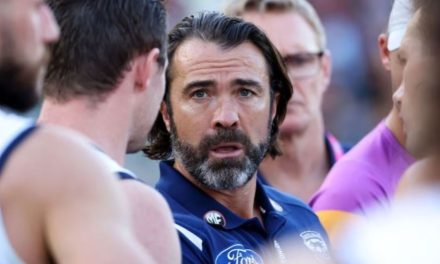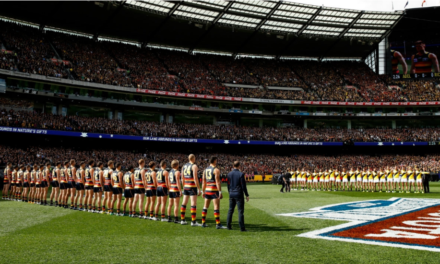Thrilling finish, but Essendon’s win over GWS was until the last 15 minutes a strangely flat affair. Photo: AFL MEDIA
We’re just on two-thirds of the way through the AFL home and away season, the bye rounds are over and now it’s all about the race to make the final eight.
So what sort of season has 2019 been so far? Pretty good, according to the AFL itself, and the metrics it uses to measure such things.
At a meeting with club football managers last week, officials produced a couple of pieces of evidence to support the case for the affirmative.
One was the closeness of games. The club representatives were told more games this year than last had been decided by five points or less, the percentage of such finishes the highest since 1980, and that teams were staying within two goals of their opponents for longer periods within games.
An increase in television audiences was also the cause of some joy, figures believed to be up substantially on last year’s numbers. So we must be in the midst of a great season, right?
Well, pardon the cynicism, but I’m not as convinced. Firstly, not by ratings as a measure of quality, certainly not when it comes to television. Have you checked out some of the dross, sorry, alternatives to football coverage, on free-to-air lately?
Personal tastes aside, though, there’s plenty of plausible explanations for a TV ratings spike. Like more standalone games on Thursday nights. Scheduling better-performed teams in prime spots like Friday evenings. “Roaming Brian” … no, just kidding.
And the close games? Well, if you’re a neutral supporter, you’d probably always prefer to watch at least a tight finish than a lopsided thrashing. But surely closeness as a measure of quality is a bit simplistic?
There’s also an obvious potential correlation between close finishes and low scoring, which continues to be the case, the slew of nine rule changes for this season having it seems only a cosmetic effect on centre bounces via the 6-6-6 rule and scoring still going down, the current points per side overage of just on 80 three points lower even than last year, the lowest-scoring since 1968.
It’s not all about scoring, though. I maintain that it’s speed of ball movement and the transition of play from one end to the other which is an even more important measure of “watchable” football, and the reduction in both those facets has been just as, if not more dramatic, than what’s happening on the scoreboard.
The new kick-in rules certainly haven’t encouraged more adventurous play out of defence. Indeed, scoring from kick-ins is currently running at just 3.9 per cent of average scores, less than last season.
Scoring from turnovers are down slightly on what they were last year, 58.1 per cent compared to 60.5 per cent, and scoring from stoppages slightly up, from 35.5 per cent to 38 per cent. But the vast bulk of scoring is still done by teams applying pressure in their forward 50s and attempting to lock the ball in there and capitalise on turnovers.
There’s also a theory that 6-6-6, rather than make the game more attractive, is actually slowing it down further. Teams winning the ball back in their defensive 50 from a centre break aren’t able to easily generate the extra numbers to create an overlap and run the ball out. Thus, careful possession football behind centre has increasingly become the norm.
Technical stuff. But how does it translate on a practical level? Well, for all the close games this season, think about how many you’d consider memorable.
I’ve seen a few rippers, certainly. The recent Carlton-Western Bulldogs clash was a beauty, the Blues twice pulling back a five-goals-plus deficit to go down by just three points, both teams reach the 100-point mark.
Greater Western Sydney’s win down at Geelong in round four was gutsy stuff, the Anzac Day Collingwood-Essendon clash in front of more than 90,000 an epic, and the Pies’ eventual 19-point win over old enemy Carlton in round eight a very entertaining game which produced a combined 10 goals in the final term.
But to be frank, they’ve been heavily outweighed in my view by the amount of dour scraps and games which, even while close, have been largely forgettable until the exciting final moments.
Even Essendon’s comeback win over GWS last week was for three quarters a strangely flat affair. The Bomber hordes at Marvel Stadium made plenty of noise in the last 15 minutes as their team surged back to snatch victory, but from my spot in the outer, seemed as subdued as I could remember beforehand, in a game which had failed to reach any great heights.
Perhaps it’s a minority view, but I’ve lately straw-polled a number of seasoned football watchers, both professional and those who watch for pleasure, and have found a consensus that season 2019 is yet to really stir the imagination. And tight finishes alone simply aren’t doing it.
There’s still a way to go, of course, and who knows what might unfold over the last eight home and away rounds then finals.
But more and more I get the feeling the sort of cautious, slower, lower-scoring brand of football of which we’re seeing more is as much about an overall mindset as it is improved defensive positioning, tactics and fitness. And the measures taken thus far simply aren’t going to break that stranglehold.
That same meeting between football managers and AFL officialdom last week also canvassed more ideas to prise the lock open. They included a forward and their opponent having to remain stationed inside 50 when there was a stoppage inside 50 at the other end of the ground.
Frankly, I don’t think even that would prove enough to have a significant impact. If we do want to open things up more I believe it’s going to take perhaps two forwards and their opponents permanently stationed inside the 50 arc, or even, more radically, a reduction of the numbers per side on the field from 18 to 16.
Good luck trying to usher those changes in, though, the great irony here being that many people who do lament the loss of a more open game are also those most resistant to more rule changes.
And it’s not just the punters. When the AFL previously conducted some trials requiring a forward and his man inside 50 when there was a stoppage in the opposite 50, the concerns raised by participants were on the physical impact on players having to move up to the play and then sprint back to be inside the 50-metre arc.
It didn’t seem to occur to them that perhaps they could just leave the forward stationed inside 50, let his man run off if he wished and run the risk of getting caught out on the rebound, and perhaps score with ridiculous ease.
Instinctively, it was all about saving a goal, not scoring one, and helping shore up numbers defensively, rather than create easier options offensively. That to me says a lot about the very clear coaching priorities in today’s game.
To me, it suggests we could have a lot more scrapping on our hands at one end with occasional breaks into space towards the other. And in the bigger picture, a lot more games looking like Mexican stand-offs before a sudden flurry of activity at the death.
Sure, those bursts can be thrilling. And this season has had a lot of them. I just think enough of us would prefer the bursts lasted the best part of four quarters rather than 15 minutes, just like, dare I say it, they once routinely did. Now that would be a good season.
*This article first appeared at INKL.












Dogs won 2016 with no key forwards ( resting Boyd , Roughy ) , Cordy a tall defensive forward charged with bringing ball to ground . Our lack of experience and talent was more than offset by our intent to pressure and attack . Tigers with Jack as the only key did the same but better . The Pies nearly did it but tried to save the game . The common thread is the intent to attack . Like you said Rohan ,it’s as if sides wait or are too scared to attack until they can see the finishing line . I just wish Essendon was less flakey ( soft) . If they were top 4 , coaches may have copied suit . Cheers to you , Finster and the crew . Robdog
“There’s also an obvious potential correlation between close finishes and low scoring”
Irony there as the intention of the rule changes this year were to increase scoring and one of the loudest voices against that was the concern there’d be more blowouts.
And now that higher scoring didn’t eventuate, the AFL conveniently forget that was the intent and spruik closer games as a good thing – despite, as you say, that is reflective of lower scoring and more dour play.
I think Jake Niall’s suggestion that Points For rather than Percentage, be used to determine ladder positions of teams on equal points. It’s a subtle thing but could make a difference as it lessens the importance of defence and increases the importance of scoring.
So it goes back to the old way of thinking, “It doesn’t matter what they score, as long as we score more”.
e.g. Richmond were trying to boost their percentage on the weekend, so it was important to both score highly, but restrict the Suns scoring. Under the Niall Ladder, the Tiges wouldn’t have cared what the Suns scored as long as they scored higher. So we might have seen a 170 to 120 result.
This article really resonates with me. After listening to your podcast, I watched the Demolition Derby between WCE and Freo.
This was the sport that I love – fast, open, unpredictable play with a lot of free running and one on one contests. I then tuned in to the snooze fest of Collingwood and Hawthorn last night. Slow, cautious, pedestrian play by teams who are too scared to make a mistake.
Someone should tell the coaches that if both teams play structured, slow, cautious football one side still loses. There are other factors in the style of play that we see; too many night games played with a slippery ball, too many interchanges that mean players can follow the ball around all night without fatigue, but the biggest one is that game is over coached. Coaches love structure and order and caution but this robs the game of its fundamental character, which should be fast, open and chaotic.
I wish I had some bright ideas to change it, but I don’t know that any of them would overcome the way the game is coached. I do support severely limiting interchange, but I fear the effect would be minor.
Thanks for the opportunity to vent.
I don’t feel as pessimistic about this as a phenomenon. I think we’re just in a bit of an in-between phase. This is slightly due to 6-6-6, but I’d attribute it far more to coaches being complete control freaks, and the fact that they don’t have runners anymore in the same on-ground-coach sorta fashion. We’ve had at least a generation of players who haven’t needed to be clever, intuitive or instinctual and rather have been preferred to be robotic, athletic automatons. Good riddance to them.
I think this is why we’re seeing teams with mature bodies, minds and leaders that also have strong structures (Geelong / WCE) doing well. I’d also suggest that this is why when it’s not going right for strong structural teams (Collingwood, Adelaide, Freo) it goes VERY wrong.
Lately I’ve been thinking a fair bit of Tom Lynch, and the evolution of footballers, and can’t help but think his way of playing might be something of the future. I always think of him as a kind of ‘trequartista’: that critical link between midfield and attack. Not a powerful beacon in a trad CHF mode – far, far more fluid, and as much as anything, smart. The player who picks the right option(s) and can execute. It’s no surprise that Adelaide have been middling in his absence.
Anyway, wholly worthwhile discussion. I just think we need a little patience for the evolution to happen.